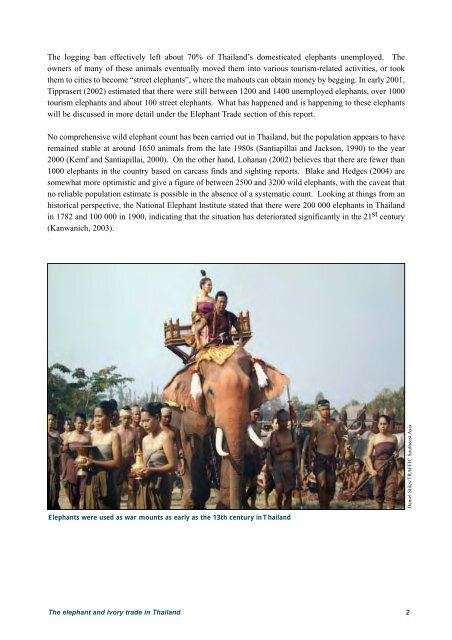The elephant and ivory trade in Thailand (PDF, 800 KB) - Traffic
The elephant and ivory trade in Thailand (PDF, 800 KB) - Traffic
The elephant and ivory trade in Thailand (PDF, 800 KB) - Traffic
You also want an ePaper? Increase the reach of your titles
YUMPU automatically turns print PDFs into web optimized ePapers that Google loves.
<strong>The</strong> logg<strong>in</strong>g ban effectively left about 70% of Thail<strong>and</strong>’s domesticated <strong>elephant</strong>s unemployed. <strong>The</strong><br />
owners of many of these animals eventually moved them <strong>in</strong>to various tourism-related activities, or took<br />
them to cities to become “street <strong>elephant</strong>s”, where the mahouts can obta<strong>in</strong> money by begg<strong>in</strong>g. In early 2001,<br />
Tipprasert (2002) estimated that there were still between 1200 <strong>and</strong> 1400 unemployed <strong>elephant</strong>s, over 1000<br />
tourism <strong>elephant</strong>s <strong>and</strong> about 100 street <strong>elephant</strong>s. What has happened <strong>and</strong> is happen<strong>in</strong>g to these <strong>elephant</strong>s<br />
will be discussed <strong>in</strong> more detail under the Elephant Trade section of this report.<br />
No comprehensive wild <strong>elephant</strong> count has been carried out <strong>in</strong> Thail<strong>and</strong>, but the population appears to have<br />
rema<strong>in</strong>ed stable at around 1650 animals from the late 1980s (Santiapillai <strong>and</strong> Jackson, 1990) to the year<br />
2000 (Kemf <strong>and</strong> Santiapillai, 2000). On the other h<strong>and</strong>, Lohanan (2002) believes that there are fewer than<br />
1000 <strong>elephant</strong>s <strong>in</strong> the country based on carcass f<strong>in</strong>ds <strong>and</strong> sight<strong>in</strong>g reports. Blake <strong>and</strong> Hedges (2004) are<br />
somewhat more optimistic <strong>and</strong> give a figure of between 2500 <strong>and</strong> 3200 wild <strong>elephant</strong>s, with the caveat that<br />
no reliable population estimate is possible <strong>in</strong> the absence of a systematic count. Look<strong>in</strong>g at th<strong>in</strong>gs from an<br />
historical perspective, the National Elephant Institute stated that there were 200 000 <strong>elephant</strong>s <strong>in</strong> Thail<strong>and</strong><br />
<strong>in</strong> 1782 <strong>and</strong> 100 000 <strong>in</strong> 1900, <strong>in</strong>dicat<strong>in</strong>g that the situation has deteriorated significantly <strong>in</strong> the 21 st century<br />
(Kanwanich, 2003).<br />
Daniel Stiles/TRAFFIC Southeast Asia<br />
Elephants were used as war mounts as early as the 13th century <strong>in</strong> Thail<strong>and</strong><br />
<strong>The</strong> <strong>elephant</strong> <strong>and</strong> <strong>ivory</strong> <strong>trade</strong> <strong>in</strong> Thail<strong>and</strong><br />
2

















